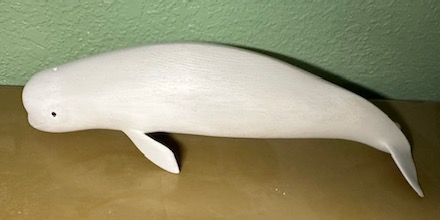
Beluga (hand-carved wood sculpture), copyrighted © by Frank Keim.
All rights reserved. Image appears here with his permission.
I first search for just the right wood,
a humble block of Pacific red cedar,
Thuja plicata, which science says is not cedar at all,
just a look-alike wood,
but it’s my choice
because of its fragrance and ease of shaping
the graceful lines of the whale’s glistening body...
I study the piece and ponder the kind of whale
that wants release from this soft-toned rufous wood,
and finally decide on a beluga,
the friendly, toothed whale with a smile
and a deep sense of trust for its poet carver...
I start by sawing a rough-cut blank
with only the hint of what it will be when I finish,
being careful to leave ample wood
on both sides of the cedar block
so its fins and tail won’t break as I work...
then I choose a rasping tool to further refine its shape
so I can begin to see the spark of its life force
and the anima it will reveal
when it’s finally freed from its prison
inside the inchoate wood...
the head is next, a bulbous thing called a melon,
filled with oil and purpose
that with echoing clicks allows these whales and their kin
to locate wary prey
to feed their mighty hunger...
then the tail fin,
such a powerful organ
as we land-born humans will never know,
which prompts my curious mind to follow a trail
far back in time, 45 million years back,
when these once terrestrial animals returned to the sea
and, losing their land-loving legs,
opted for up and down propulsion
as their mammalian backbone would only allow...
next the pectoral fins that once were forelegs
but are now curving appendages as smooth as satin
for propelling and steering the whale
in its aqueous medium,
but oh, so fragile in the last moments
of their whittling by my knife and file
that once and twice they broke
and I had to mend them
so the fins could swim
when the carving was done...
the round affable eyes are next
that, along with echoing clicks,
help the beluga see and hunt
his wary fish-finned and cephalopodic prey,
and escape the stealth of his piebald enemies,
the ultimate hunters of the sea world
waiting with long dorsal fins and powerful teeth
for just the right moment to swoop in by surprise
and bloody the life and death
of this wondrous creature—
the ultimate law,
nature raw in tooth and jaw...
and lest I forget, to carve the blow hole,
yes, like the ones I heard one twilight night
while skiing near a Yup’ik Eskimo village
on the frozen shore ice of the Bering Sea,
when a score of belugas drifting like pale phantoms
under the cold black water of a misty open lead
suddenly surfaced, all of them together,
and blew their held breath into the dark,
sounding like staccato rifle shots,
then inhaled, all of them together,
and dove back under the water
to avoid certain danger from a stranger
beside them on the ice...
finally, the longest most patient process of all,
of sanding with finer and finer sandpaper,
then painting with the whitest of white color
the pallor of ice pans floating
in shimmering jet-black water,
to protect my whale from peril
from above and below
and let him live long in frigid seas,
find a mate and procreate,
and survive as he was intended to,
as yet another preternatural, almost magical,
creature of our arctic seas.
—Fairbanks, Alaska; November, 2023
is an educator, nature writer, and environmental activist who has resided in Alaska since 1961. He worked for two years as a Peace Corps Volunteer on the Bolivian Altiplano; as an anthropologist in Ecuador for four years; and as a secondary school teacher of Yup’ik Eskimos in four small Eskimo villages in Alaska’s Lower Yukon Delta for 21 years. He has three poetry books published: Voices on the Wind (2011), Today I Caught Your Spirit (2014), and Trails Taken ... so many still to take (2018). His Wilderness River books were published in 2012 and 2020 respectively: White Water Blue: Paddling and Trekking Alaska’s Wild Rivers, and Down Alaska’s Wild Rivers: Journals of an Alaskan Naturalist.
Frank enjoys canoeing, wood carving, and drawing birds for an in-progress online book entitled Yup’ik Bird Book. He lives in an octagon that he and his wife, Jennifer, built themselves north of Fairbanks, Alaska.